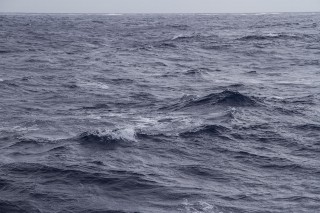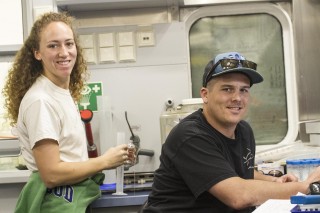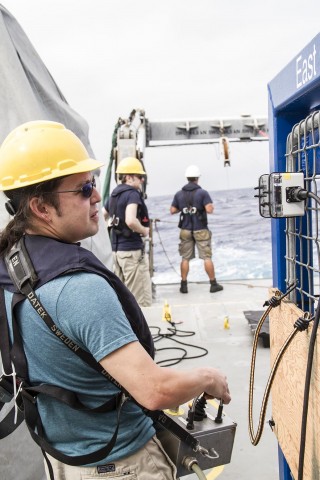
Dr. Mak Saito, chief scientist of the Life Without Oxygen expedition, opens the daily morning meeting with good news: “The water has been really interesting and we’re ahead of schedule. I’d like to add one more CTD cast station.” With everyone’s attention, he elaborates, “The O2 in the water is lower than we expected. We want to collect more data.”
The expedition is starting off on the right foot. The labs are ready, the outlook amongst the scientists is positive and energetic, and the results for the very first CTDs are intriguing. Granted, if the ocean was a little calmer and research crew didn’t have to wear seasickness patches, things could be even better. Last night the ship was rocking and rolling, making CTD deployments a bit more challenging. But as captain Berndt Buchner puts it “This is just your typical Southern Pacific weather.”

All of the aspects that the scientific team can actually control, however, are going great. They have come here to deepen our understanding of Oxygen Minimum Zones in the Tropical Pacific. Many of our readers may wonder how the crew plans on gather data and processing it into answers.
Start with Educated Guesses
Not just any educated guess of course. The scientists rely on detailed data coming up from the depths through the rosettes that are deployed on the aft and starboard of R/V Falkor. This way the researchers can determine which segments of the transect deserve a closer look.

As the bottles within the rosettes sink more than 1000 meters into the ocean, they send real-time data to the visual matrix at R/V Falkor’s dry lab. This data includes amount of dissolved oxygen, salinity, temperature, light, presence of chlorophyll, floating particles, and of course, depth.
After observing what information the rosette is transmitting, the oceanographers decide which depths are more interesting, and they signal the bottles gather water samples. As the bottles come up, their lids close when a Marine Technician, under directions from the scientists, triggers a signal down the line.
So Small, Yet So Relevant

Once the rosette is back onboard, the team begins to retrieve the samples for later analysis. There is no shortage of work, for they are dissected thoroughly: microbes, gases, reactions… there’s no escaping the meticulous eyes of the team.
All of the seawater collected is processed to identify the microbial organisms functioning inside of the sample. The small organisms’ actions and the processes carried out by them are paramount for life in the oceans, and therefore for our planet.
By comparing the characteristics of the water from which the samples were taken, and correlating that to the kind and amounts of organisms found, the scientists are able to create a baseline profile of the processes that take place on different segments of the oxygen minimum zones in the Earth’s oceans.
“Happy?”
This is the question that Leighton Rolley, Lead Marine Technician, has for Dr. Alyson Santoro, a microbial oceanographer onboard. Is the data believable? Does it look right?
And he receives a positive answer – Yes, it looks amazing. The first samples, already categorized and processed at the lab, are very exciting. This just is the first step in an nearly month-long expedition, but things are off to a great start!

